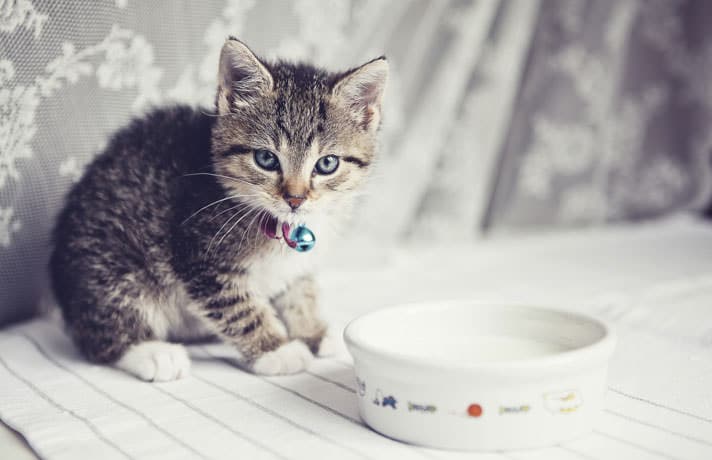Cats and milk seem like a natural combination. The classic image of a cat licking a saucer of cream or farm kittens enjoying fresh milk from a cow has appeared in literature and art for decades, and you’ve probably seen it at home and on the farm. Yet this picturesque image doesn’t tell the whole story.
As mammals, we all share a common start drinking mother’s milk. After weaning from Mom’s milk to solid foods, most mammals stop drinking milk, and many can experience gastrointestinal upset after ingesting dairy products.
What happened?
How Lactose Affects Cats
Milk contains a carbohydrate called lactose, which is a disaccharide sugar made up of galactose and glucose and found in all types of milk, in varying percentages in each species, says Sara Witherell, a board-certified associate veterinarian at Animal Kind Veterinary Hospital in Brooklyn, New York. Kittens, like other baby mammals, have an inborn ability to break down lactose because their bodies produce the enzyme lactase, which splits lactose into single sugars, thus helping them digest lactose.
To some degree, all species lose the ability to break down lactose as they age, Witherell says, adding that when kittens wean, at around 4 to 6 weeks of age, their ability to break down lactose lowers.
“Between weaning and 6 months of age, they’ve lost this ability to produce the enzyme lactase and break down lactose,” she says. When the body produces less lactase, it has less ability to digest lactose, and that’s when you might start seeing signs of lactose intolerance. Also, once the body stops producing lactase, it never re-starts.
When a lactose-intolerant cat ingests dairy, the undigested lactose pulls a lot of water into the intestines and bacteria ferment the undigested sugars, says Ann Hill, a board-certified veterinarian at Canfield Vet, Dog and Cat Hospital in Pittsford, New York. The results are stomach upset, gas, cramping, bloating and diarrhea—usually within eight to 12 hours of ingesting the dairy product.
This is different from a cat food allergy or allergic reaction. With allergies, the body views a substance as an invader and the immune system attacks. The symptoms generally show up on the skin as rashes and itchiness. The response also intensifies each time the body is exposed to that allergen. Intolerance symptoms only last as long as the item—lactose, in this case—remains in the body. Once digested or expelled, the symptoms cease.
Cats And Dairy: An Inescapable Attraction
Most cats I’ve lived with are attracted to milk products, wanting at least a look and sniff at what I’m eating, and some even help themselves to a taste. Open some cheese or ice cream and my Manx cat Tripper would race over and insist on checking it out, and sometimes he acted like he wanted some for himself.
After offering him tiny tastes in his cat food bowl on several occasions, however, I learned that beyond a sniff and a lick, Tripper’s enthusiasm quickly disappeared, and he would leave the “treat” behind. But I’ve watched my parent’s and friends’ cats lap up milk from a cereal bowl or the yogurt remnants from a small container with no signs of intolerance.
“Cats like dairy because they are drawn to protein and to fat, so if something tastes fatty to them, it generally tastes good to them,” Hill says.
Veterinarians agree that foods like milk, yogurt, cheese and other items with lactose are not necessary for a balanced diet for adult cats and should be avoided if the cat has irritable bowel syndrome or inflammatory disease in their intestines, because the lactose will upset the cat’s system.
“Because a large percentage of cats are not lactose tolerant, and these foods can unbalance their diet because of the fat and protein content, it’s not the best option,” Witherell says.
However, she adds that little bits are probably OK if the item has a low percentage of lactose and is not disrupting protein and fat levels in the cat’s diet.
The chemical makeup of lactose is the same in all milks, from human to cow to cat, but the percentages vary for each species, Witherell explains. For example, human milk contains about 6 to 7 percent lactose, while cow, goat, sheep and cat milk contains about 4 to 5 percent.
Some milk products, such as butter, some ice creams and cheeses, actually contain much less lactose than the fluid milk itself because fermentation and other processes break down the lactose in some foods making them more tolerable than others. Cottage and cream cheese, for example, contain about 1 to 3 percent lactose.
In Hill’s experience, most cat owners offer such small quantities it doesn’t affect their pets.
“If your cat likes these treats, I recommend feeding them a lactose-free milk,” she says. “There is milk marketed for cats, and that’s a better bet.”
And Witherell says lactose intolerance doesn’t come up clinically very often.
“In general, I tell people to stick with products formulated for cats, but they really don’t need it,” she says. “Just offer a well-balanced diet beyond weaning age.”
Wise Treats For Your Cat
If you want to give your cat dairy treats, but you aren’t sure she can tolerate dairy products, experts recommend offering your cat a very small amount, like a tablespoon or two of milk, and watching for symptoms. If no symptoms present up to a day afterward, she probably will be fine with an occasional milk treat.
You also can try small quantities of cheese, yogurt and other cultured dairy products to further minimize the chances of an intolerance reaction.
Because dairy, milk replacers and similar products do not replace a balanced diet, and they add calories, protein and fat to your cat’s current diet, remember to count them as part of your cat’s daily calorie intake to prevent overfeeding and other health issues.
By: Sandy Chebat
Feature Image: marzena_cytacka/iStock/Thinkstock
Share:









